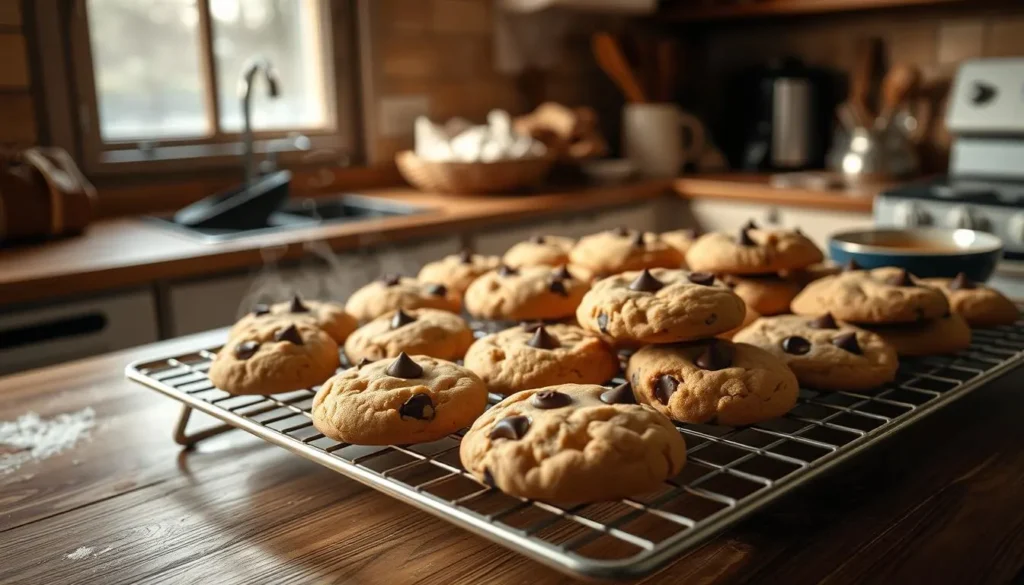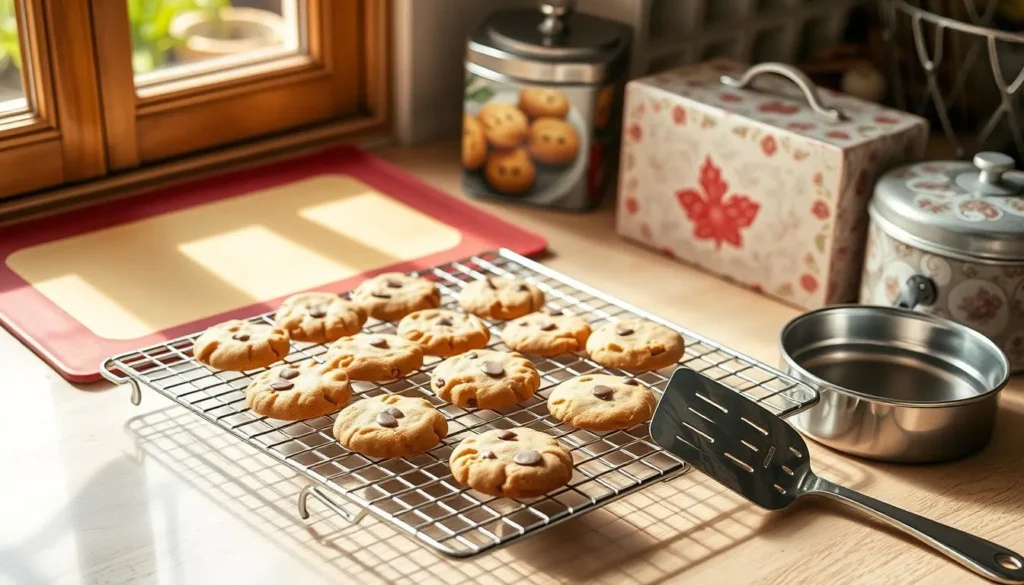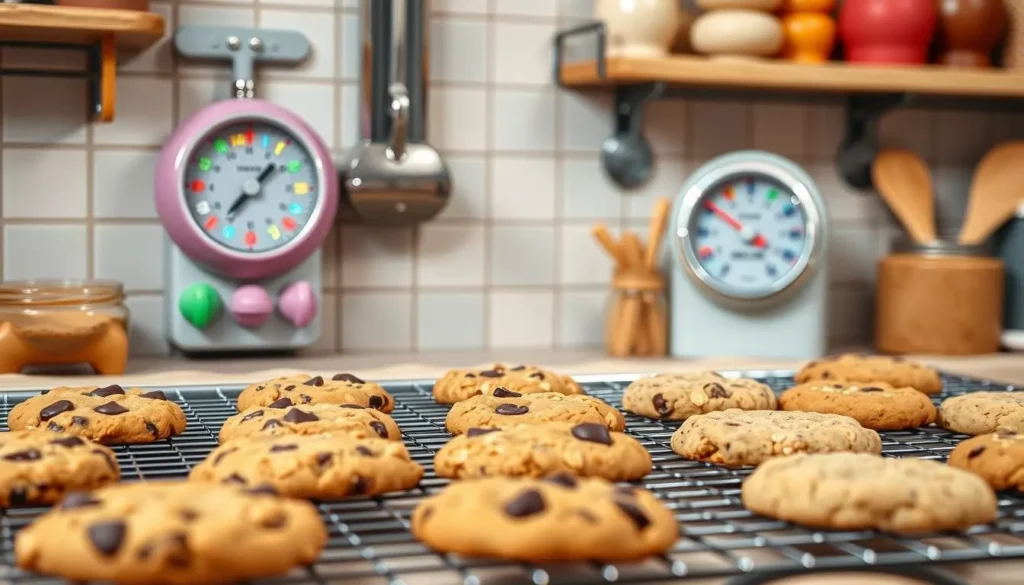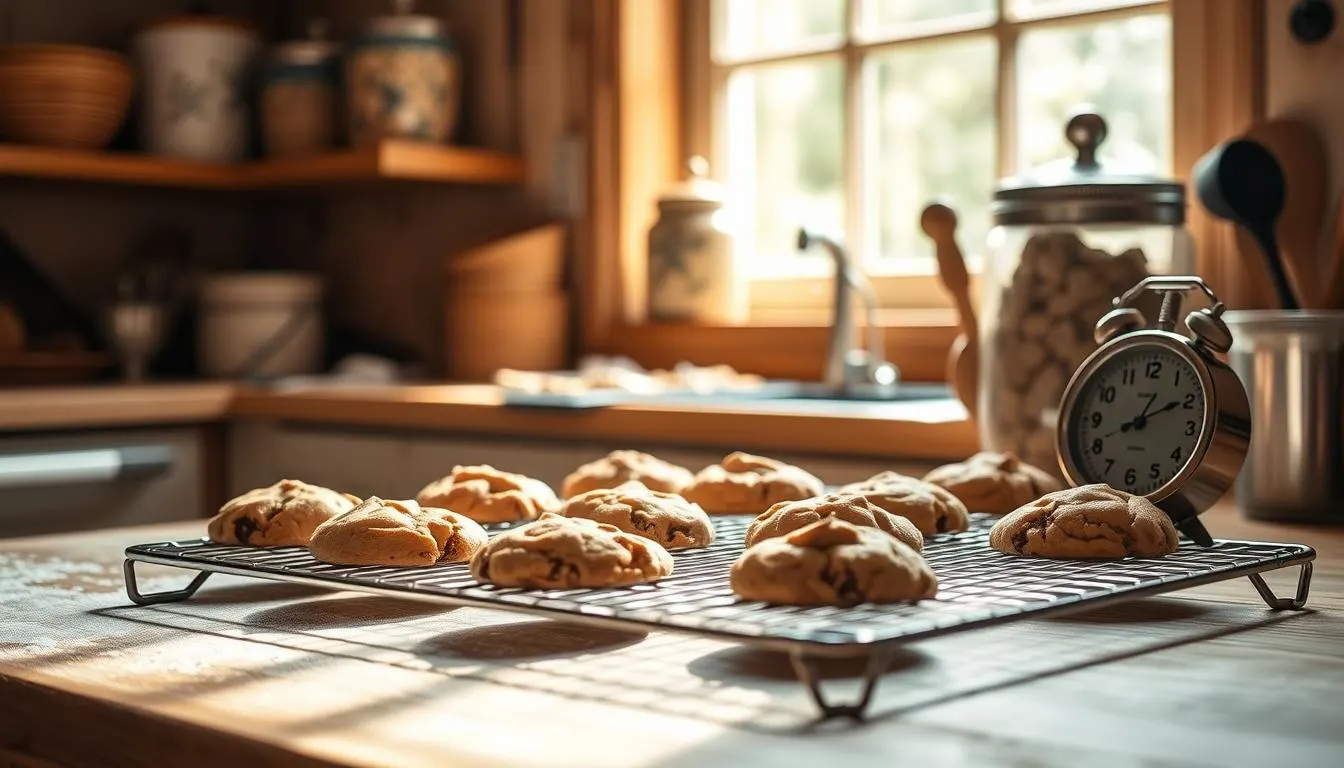Ever pulled a batch of fresh cookies from the oven and wondered how long to let cookies cool before enjoying them? As a passionate baker, I’ve learned that patience is the secret ingredient to perfect cookie cooling. Mastering the cooling process transforms cookies from ordinary to extraordinary, ensuring the perfect balance of texture and taste. Check out these unique cookie recipes for inspiration.
Mastering baking tips for cookie cooling can dramatically improve your perfect cookie texture. Each cookie requires careful attention, from the moment it leaves the oven to its final resting place on the cooling rack. Whether you’re a novice baker or a seasoned pro, knowing exactly how to cool your cookies can make all the difference between a crumbly mess and a delectable delight.
The science of cookie cooling goes beyond simply waiting. Temperature, humidity, and even the type of cookie sheet you use play important roles. Professional bakers understand that cookie cooling is more than a waiting game—it’s a precise process that demands understanding and skill.
In this guide, you’ll discover everything you need to know about letting cookies cool perfectly. We’ll discover the techniques, timing, and tricks that will improve your baking from good to phenomenal. Get ready to transform your cookie-making experience with expert insights that will have everyone asking for your recipe.
Understanding Cookie Cooling Basics
Learning how to cool cookies is key in baking. It makes your homemade treats go from good to great. The right temperature is important for the perfect texture and taste.

Cooling cookies isn’t just waiting for them to cool. It’s a science that changes their quality. The time after taking them out of the oven is key for their texture and structure.
Why Proper Cooling is Essential
Proper cooling makes cookies just right. When they come out of the oven, they’re soft and keep cooking. The right cooling method confirms:
- Optimal texture development
- Structural integrity
- Upgraded flavor concentration
- Prevention of structural breakdown
The Science Behind Cookie Cooling
Baking science shows us how cooling works. Will cookies harden as they cool? Absolutely, because as they cool, their molecules change, solidifying their structure. Fats solidify, sugars crystallize, and proteins set, making the texture you want.
“Cooling is where the magic happens in cookie baking—it’s the final stage of transformation.”
Temperature Dynamics During Cooling
Temperature control is essential for achieving perfect cookies. Cookies will harden as they cool, and the cooling area affects how fast they set and achieve their final texture. Room temperature, humidity, and air flow are all important. Learn more about the importance of temperature control in baking.
Professional bakers suggest using wire racks for cooling. This allows air to circulate, helping cookies cool evenly. It also prevents moisture buildup that could ruin their crisp edges.
Essential Equipment for Cooling Cookies
Mastering cookie cooling is more than just waiting. The right tools can make your baking better. Choosing the right cooling racks and baking sheets is key for great cookies.

Your essential cookie cooling toolkit should include several key items:
- Wire cooling racks
- Baking sheets
- Spatulas
- Parchment paper
Let’s examine the most recommended kitchen tools for cookie cooling:
| Tool | Purpose | Average Cost |
|---|---|---|
| Sur La Table Stainless Steel Cooling Grid | Quick and efficient cookie cooling | $11-$17 |
| OXO Good Grips Stainless Steel Scraper | Transferring cookies without breaking | $15-$20 |
| Parchment Paper Sheets | Preventing sticking and easy cleanup | $18-$25 |
Wire cooling racks are very important. They let air get to your cookies, stopping them from getting soggy. Look for strong racks that keep cookies from falling and let air flow well.
“The right cooling rack can make the difference between good and great cookies.” – Professional Baker’s Tip
Your baking sheets are important at first. Pick heavy-duty sheets that heat evenly and support your cookies. A thin, flexible spatula helps move delicate cookies without breaking.
Good kitchen tools are a must for home bakers. They make cooling easier and keep your cookies perfect in taste and texture.
How Long to Let Cookies Cool
Knowing how long to cool cookies is key for perfect texture and taste. Cooling cookies involves several stages that affect your baking results.

Letting cookies cool after baking is an art that needs patience and precision. Different cookies cool differently, which can greatly impact your baking.
Initial Cooling on Baking Sheet
When cookies first come out, they need a brief time to settle. Cookie cooling times start with a 1-2 minute rest on the baking sheet. This short time helps the cookies:
- Set their structure
- Finish slight internal cooking
- Become firm enough to move
Cooling Rack Time Guidelines
After resting, move your cookies to a wire cooling rack. Most cookies need 20-30 minutes to cool completely. The rack helps air circulate, preventing moisture and ensuring crispness.
Different cookies cool at different rates:
- Thin cookies: 15-20 minutes
- Thick, soft cookies: 30-45 minutes
- Delicate cookies: Handle with extra care
Complete Cooling Duration
Patience is essential when cooling cookies. Complete cooling keeps cookies at their best texture and ready for storage or decorating. Rushing can cause moisture issues and lower quality.
“Perfect cookies are worth the wait!” – Baking Experts
For the best results, let cookies cool to room temperature before storing. This prevents moisture and keeps cookies fresh and tasty.
The Role of Wire Cooling Racks
Wire cooling racks are key for perfect cookies. They help with even cooling and texture. These tools make baking better by letting air flow around your cookies.
Choosing the right wire rack is important. Stainless steel racks are the best for several reasons:
- Prevent moisture buildup
- Maintain crisp edges
- Make sure consistent cookie texture
- Allow complete air circulation
Wire racks come in different materials, each with its own benefits. Think about these when picking your rack:
| Material | Pros | Best For |
|---|---|---|
| Stainless Steel | Heat-resistant, durable | High-temperature baking |
| Chrome | Lightweight, affordable | Standard cookie cooling |
| Silicone-Coated | Non-stick surface | Delicate baked goods |
Using wire racks right helps your cookies get the best cookie texture. They keep your cookies crisp and prevent them from getting soggy.
“A great wire rack is like a personal cooling assistant for your cookies” – Professional Baker’s Insight
Pro tip: Always pick a rack that’s sturdy and has enough space. This lets air flow well around your cookies.
Alternative Cooling Methods Without a Rack
Don’t worry if you don’t have a traditional wire cooling rack. There are many cookie cooling alternatives using everyday items. These homemade methods can cool cookies just as well as racks.
Your kitchen has many surfaces that can cool cookies perfectly. The trick is to let air circulate and avoid moisture buildup.
Paper Towel Cooling Technique
A simple paper towel can help cool cookies. Place cookies on clean paper towels to soak up extra moisture. This is great for:
- Greasy or buttery cookies
- Delicate baked goods
- Cookies with high fat content
Countertop Cooling Techniques
Your kitchen countertop has many cooling options. Try these creative ideas:
- Use a clean wooden cutting board
- Spread parchment paper on a flat surface
- Use a large ceramic plate
Makeshift Cooling Solutions
Be creative with these homemade cooling ideas:
- Crumpled aluminum foil: Use it to create a raised surface that allows air to circulate around the cookies
- Use removable gas stove grates
- Repurpose clean baking sheets
- Arrange metal cookie cutters for elevation
“Creativity in the kitchen means finding solutions with what you have!” – Professional Baker’s Tip
Always clean surfaces before cooling cookies. Make sure air can circulate to avoid soggy cookies.
Signs That Cookies Are Properly Cooled
Understanding when cookies are done is key to their perfect taste and texture. Once they’re ready, cooling them is the final step to making them delicious.
Here are the signs that cookies are cooled right:
- Firm texture when touched
- No residual heat on the surface
- Solid add-ins like chocolate chips
- Completely set bottom surface
Yes, cookies get harder as they cool down. This is when they reach their best texture at room temperature. The cooling phase is where magic happens.
“A perfectly cooled cookie is a baker’s true masterpiece.” – Pastry Chef Emma Roberts
Professional bakers suggest using a digital thermometer to check cookies. The best temperature is between 175-185°F (79-85°C). This guarantees they taste and feel just right.
| Cooling Stage | Key Indicators | Expected Outcome |
|---|---|---|
| Initial Cooling | Slight softness | Continues to set |
| Room Temperature | Firm to touch | Complete texture formation |
| Final Stage | No heat, crisp edges | Perfect cookie consistency |
Keep in mind, different cookies cool differently. Being patient during cooling confirms your treats turn out the best.
Common Cookie Cooling Mistakes to Avoid
Mastering cookie cooling can be tricky. Many home bakers face issues that ruin their treats. Knowing these common mistakes will make you better at baking cookies.
Fixing cookie cooling problems starts with spotting challenges. Let’s look at the most common mistakes that can ruin your cookies.
Rushing the Cooling Process
Being impatient can ruin your cookies. Will cookies harden as they cool? Yes, but moving them too soon may cause them to break before they firm up. Moving them too fast can make them break and crumble.
- Wait 2-3 minutes before trying to move cookies
- Let cookies set and firm up naturally
- Use a thin spatula for a gentle transfer
Improper Storage While Cooling
Covering warm cookies traps moisture, making them soggy. Proper cooling needs good air flow to keep the texture right.
| Storage Method | Impact on Cookies |
|---|---|
| Sealed Container | Traps moisture, causes sogginess |
| Open Rack | Allows air circulation, maintains crispness |
| Paper Towel | Absorbs excess moisture |
Temperature-Related Issues
Temperature is key in cooling cookies. Overcooling makes cookies dry and hard. Undercooling stops them from getting the right texture.
“Perfect cookies require patience and precision in cooling.” – Professional Baker’s Wisdom
Avoiding these common mistakes will help you make delicious cookies every time. Remember, getting better at cookie troubleshooting takes practice.
Impact of Cookie Type on Cooling Time
Knowing how different cookies need special baking techniques is key to getting them just right. Not all cookies cool at the same speed. This means how you cool them is just as important as how you bake them.
Different cookie types need different cooling strategies:
- Thin, crispy cookies cool rapidly, often needing just 2-3 minutes
- Thick, chewy cookies require longer cooling periods to set properly
- High-fat cookies like chocolate chip need more cooling time
- Dense cookies such as shortbread cool more quickly
Professional bakers know that cooling time impacts cookie texture as much as ingredient selection.
When figuring out how long to wait for cookies to chill, remember these important factors:
| Cookie Type | Cooling Time | Texture Impact |
|---|---|---|
| Chocolate Chip | 8-10 minutes | Soft, chewy center |
| Shortbread | 3-5 minutes | Crisp, firm structure |
| Oatmeal | 6-8 minutes | Slightly crumbly |
Your baking techniques should change for each cookie type. This guarantees the best cooling and keeps the texture and flavor just right.
Storage Tips After Cooling
Keeping cookies fresh is key. After they cool down, the right storage makes a big difference. It keeps them tasting great and feeling just right.
Experts say a few important things for storing cookies:
- Use airtight containers to keep cookies away from moisture and air
- Keep different cookie types separate to avoid flavor mixing
- Choose room temperature or freezer storage based on the cookie type
Vaughn Vreeland recommends using quart-sized airtight containers or takeout containers. They offer great protection and help keep cookies fresh.
“The right storage can extend your cookies’ shelf life from days to weeks!” – Melissa Clark
How long cookies last depends on their type:
| Cookie Type | Room Temperature | Freezer Storage |
|---|---|---|
| Standard Cookies | 3-5 days | Up to 6 months |
| Cookie Bars | 2 weeks | 4-6 months |
| Delicate Cookies | 2-3 days | 3-4 months |
Pro baking tip: For soft cookies, add a slice of bread to the container. It helps keep them soft for about a week.
When sending cookies, use tissue paper or wax paper to cushion them. Always let cookies cool completely before packing to avoid moisture buildup.
The Effect of Room Temperature on Cooling Time
Understanding environmental factors is key to knowing how long cookies take to harden. Room temperature greatly affects the cooling process. It changes the baking conditions and the final cookie texture.
Temperature changes can greatly affect your cookie cooling experience. Warmer rooms make cookies cool slower, while cooler rooms speed up the process. Your kitchen’s temperature is very important for perfect cookies.
“Every degree matters when cooling cookies – your room’s temperature can make or break the final texture.”
Temperature Impact Factors
- Warm rooms (70-80°F): Slower cooling, potentially softer cookies
- Cool rooms (60-65°F): Faster cooling, more structured texture
- Humidity levels affect moisture retention
Cooling Time Guidelines
| Room Temperature | Cooling Duration | Cookie Texture Result |
|---|---|---|
| Below 65°F | 15-20 minutes | Crisp edges, firm center |
| 70-80°F | 25-30 minutes | Softer, more delicate texture |
Pro tip: Use a wire rack in a consistent temperature area for even cooling. Avoid drafty windows or heat sources that might create uneven cooling conditions.
By focusing on your room’s environmental factors, you’ll get better at cooling cookies. You’ll always make delicious results.
Conclusion
This cookie cooling guide has given you key baking tips for making delicious treats. Learning how to cool cookies makes baking a special adventure. It turns a simple task into a fun culinary journey.
Getting the cookies just right is all about precision. And yes, cookies will harden as they cool, so patience is an essential ingredient in the baking process. It’s important to be patient and pay close attention to detail. This way, your cookies will set perfectly, with the right texture and taste.
By using the tips from this guide, you’ll get better at baking. Each cookie type needs its own cooling method. From crunchy chocolate chip to soft shortbread, you’ll know how to do it right. This knowledge will help you make treats that everyone will love.
With practice and the tips from this guide, you can make your kitchen feel like a pro bakery. Trust the process, follow the techniques, and enjoy the sweet results of your baking skills.
FAQ
How long do I need to let cookies cool after baking?
Most cookies need 5 minutes on the baking sheet first. Then, they cool for 20-30 minutes on a wire rack. The exact time depends on the cookie’s type and thickness.
Why are wire cooling racks important for cookies?
Wire racks are key because they let air circulate around the cookies. This prevents moisture buildup and keeps the cookies crisp. It also helps them cool evenly.
Will cookies harden as they cool?
Yes, cookies will harden as they cool because cooling allows the fats to solidify and sugars to crystallize, creating the perfect texture.
Can I store cookies immediately after baking?
No, wait until cookies are completely cool before storing. Storing them warm can make them soggy and may cause mold. Make sure they’re at room temperature and firm before storing in an airtight container.
How do different types of cookies affect cooling time?
Cooling times vary by cookie type. Thin cookies cool fast, while thick ones like chocolate chip take longer. Drier cookies cool faster than moist ones.
What’s the best way to cool cookies without a wire rack?
Without a wire rack, use paper towels to absorb moisture. You can also cool on a wooden cutting board or a makeshift rack. The goal is to let air circulate around the cookies.
How can I tell if cookies are completely cooled?
Cooled cookies are firm and have no heat left. The bottom should be set, and chocolate chips solid. Use a thermometer for 175-185°F (79-85°C).
Does room temperature affect cookie cooling?
Yes, room temperature and humidity influence cooling times. Warmer rooms need longer cooling, while cooler ones speed it up. High humidity can slow down the crisping process.

